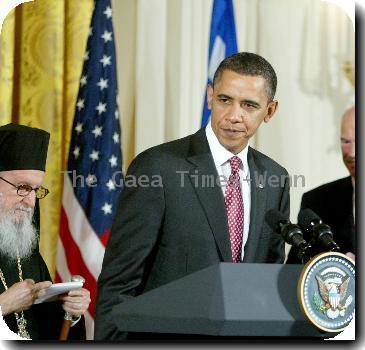Nuclear ‘haves’ and ‘have-nots’ debate into final days of UN treaty conference
By Charles J. Hanley, APWednesday, May 26, 2010
Nuke ‘haves,’ ‘have-nots’ in final haggling at UN
UNITED NATIONS — Nuclear-armed and non-nuclear nations entered the final days of a monthlong treaty conference Wednesday haggling over the trade-off between steps to disarm those with the weapons and steps to keep atomic arms from those without.
The final three days of the twice-a-decade gathering to review the Nuclear Nonproliferation Treaty promised long hours of intense debate.
The conference president, Libran Cabactulan of the Philippines, assured delegates in a closed-door session Wednesday that “substantive consultations” were under way in a “dynamic” process to turn his 29-page draft proposal into a final declaration that would be acceptable by all 189 nations by Friday.
Those consultations had risen to top levels in global capitals. Away from the U.N.’s halls, “there are some very high-level discussions going on as we speak,” a Western diplomat told reporters, on condition of anonymity because of the sensitivity of the talks.
Diplomats still need to bridge differences over how ambitiously nuclear-weapons states should move toward complete nuclear disarmament, and over what stricter controls others should accept to check the spread of these ultimate weapons.
The 40-year-old Nuclear Nonproliferation Treaty, or NPT, a cornerstone of arms control, is based on a global bargain: Nations without nuclear weapons committed not to acquire them; those with them committed to move toward their elimination; and all endorsed everyone’s right to develop peaceful nuclear energy.
Members include every nation but India, Pakistan, Israel and North Korea — treaty outsiders that have or are suspected of having atomic arsenals.
Treaty states, including the recognized nuclear powers United States, Russia, Britain, France and China, gather every five years to review how the NPT is working and to agree, in a consensus final document, on steps to advance the NPT’s goals.
The 2005 conference failed to adopt a final declaration, in part because the administration of former U.S. President George W. Bush, unenthusiastic about arms control diplomacy, refused to reaffirm the U.S. commitment to 13 steps toward disarmament approved at the 2000 meeting. Those included such actions as ratifying the treaty banning all nuclear tests.
The reversal of U.S. attitudes under President Barack Obama, who embraces the goal of nuclear disarmament, has helped restore a cooperative atmosphere.
“There’s a better than even chance” for a consensus document, said longtime conference observer Rebecca Johnson of the British-based Acronym Institute for Disarmament Diplomacy. “All the elements are there now.”
In a move to encourage agreement, the British government on Wednesday offered its first public accounting of its nuclear arsenal, saying it has a stockpile of 225 warheads. That followed a U.S. disclosure in early May that it has 5,113 nuclear warheads and “several thousand” more retired weapons awaiting dismantlement.
Treaty states without nuclear weapons have long demanded openness about the size and nature of nuclear arsenals, as an essential step toward negotiating complete disarmament. They also have pushed for a clear timetable for such negotiations.
An early committee draft here called for a global conference in 2014 to begin talks on abolishing nuclear arms. That date has been dropped under pressure from the five nuclear powers, but Cabactulan’s draft still calls for the weapons states to consult among themselves on how to disarm and report back to the 2015 conference, after which the U.N. secretary-general would convene “an open-ended high-level meeting to take stock and agree on a roadmap for the complete elimination of nuclear weapons.”
The weapons states are expected to continue to resist such timelines in a final document.
“I think we have to retain a degree of flexibility,” Alistair Burt, British Foreign Office minister, told reporters Wednesday when asked about proposed disarmament time frames.
As for the other side of the NPT bargain, the president’s draft would have the conference urge all nations to accept the “additional protocol” of the International Atomic Energy Agency. Much more intrusively than under standard safeguards agreements, the protocol allows the U.N. watchdog agency to conduct inspections of suspect nuclear material and sites anytime and anywhere.
Brazil, South Africa and other developing nations object that these are overly intrusive measures, especially when contrasted with the secretiveness of the nuclear powers’ arsenals. They also dislike proposals to tighten up the nuclear trade, fearing this would limit their ability to develop nuclear power.
One other “make-or-break” issue looms this week: The Arab states’ effort to convene negotiations on a treaty establishing the Middle East as a zone free of weapons of mass destruction, a goal set at the 1995 NPT conference but not acted on.
The plan is aimed at pressuring Israel to give up its unacknowledged nuclear arsenal. The Obama administration says it favors “practical measures” toward that goal, although it suggests that greater peace must first be achieved in the Mideast. Cabactulan’s draft proposes a 2012 conference on the subject.
AP correspondent Edith M. Lederer contributed to this report.
Tags: Barack Obama, Energy, International Agreements, North America, Nuclear Weapons, Political Issues, United Nations, United States, Utilities, Weapons Administration, Weapons Of Mass Destruction

